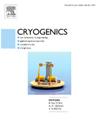Effect of temperature and heat input on helium isotope separation driven by an entropy filter
IF 2.1
3区 工程技术
Q3 PHYSICS, APPLIED
引用次数: 0
Abstract
To understand the effect of temperature and heat input on helium isotope separation driven by an entropy filter, the thermomechanical flow of superfluid helium through an entropy filter for obtaining high purity 4He is experimentally investigated. For this method, there are two important indicators: separation flow (flow rate) and separation effect (3He concentration). The separation flow rate is examined at various temperatures ranging from 1.6 K to 1.9 K of feed helium. Different heat inputs (Q) are applied to the entropy filter outlet to drive superfluid 4He flowing through the porous element. The results demonstrate that the flow rate increases as the feed helium temperature decreases and heat input increases. Simultaneously, 3He diffusion is detected as the superfluid helium passes through the entropy filter. The concentration of 3He, filtered at different temperature ranging from 1.6 K to 1.9 K, are analyzed using HELIX SFT Static Vacuum Mass Spectrometer. The findings reveal that the 3He concentration decreases with an increase in the temperature of the feed helium bath. 3He concentration of feed helium is around . Specifically, the 3He concentration in the filtered helium at 1.6 K is approximately , while at 1.9 K, it reduced to . This suggests that 3He diffusion in He II is inversely proportional to the He II temperature from 1.6 K to 1.9 K, resulting in a lower 3He concentration at higher temperatures.
温度和热量输入对熵滤器驱动的氦同位素分离的影响
为了了解温度和热输入对熵过滤器驱动的氦同位素分离的影响,我们对超流体氦通过熵过滤器获得高纯度 4He 的热力学流动进行了实验研究。该方法有两个重要指标:分离流量(流速)和分离效果(3He 浓度)。在进料氦的 1.6 K 到 1.9 K 的不同温度下,对分离流速进行了研究。对熵过滤器出口施加不同的热输入(Q),以驱动超流体 4He 流经多孔元件。结果表明,随着进料氦气温度的降低和热输入的增加,流速也在增加。同时,当超流体氦通过熵过滤器时,检测到 3He 扩散。使用 HELIX SFT 静态真空质谱仪分析了在 1.6 K 至 1.9 K 不同温度下过滤的 3He 浓度。研究结果表明,3He 浓度随着进料氦浴温度的升高而降低。进料氦的 3He 浓度约为 3.3×10-8。具体来说,在 1.6 K 时,过滤氦中的 3He 浓度约为 3.2×10-10,而在 1.9 K 时,则降至 2.2×10-10。这表明,从 1.6 K 到 1.9 K,3He 在 He II 中的扩散与 He II 的温度成反比,导致在较高温度下 3He 浓度较低。
本文章由计算机程序翻译,如有差异,请以英文原文为准。
求助全文
约1分钟内获得全文
求助全文
来源期刊

Cryogenics
物理-热力学
CiteScore
3.80
自引率
9.50%
发文量
0
审稿时长
2.1 months
期刊介绍:
Cryogenics is the world''s leading journal focusing on all aspects of cryoengineering and cryogenics. Papers published in Cryogenics cover a wide variety of subjects in low temperature engineering and research. Among the areas covered are:
- Applications of superconductivity: magnets, electronics, devices
- Superconductors and their properties
- Properties of materials: metals, alloys, composites, polymers, insulations
- New applications of cryogenic technology to processes, devices, machinery
- Refrigeration and liquefaction technology
- Thermodynamics
- Fluid properties and fluid mechanics
- Heat transfer
- Thermometry and measurement science
- Cryogenics in medicine
- Cryoelectronics
 求助内容:
求助内容: 应助结果提醒方式:
应助结果提醒方式:


